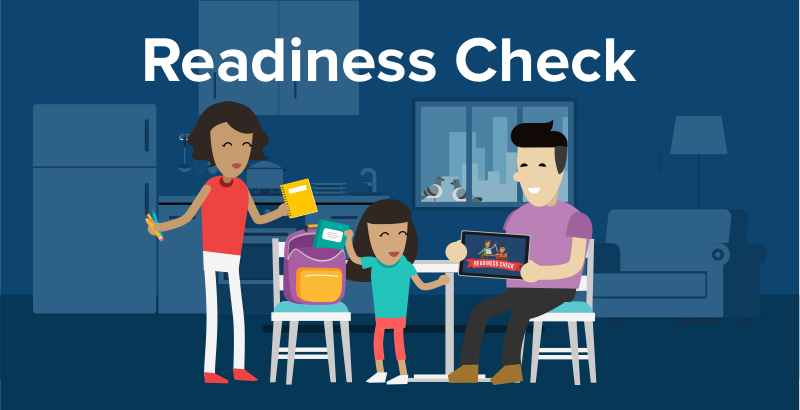Closing the ‘Perception Gap’: With 3 in 5 Teachers Saying Students Are Not at Grade Level on First Day of School, New Digital Tool Offers Parents a ‘Readiness Check’

Most parents think their kids are ready for the next grade. In fact, 90 percent believe their child is academically on par with or above their peers in their grade.
However, only 39 percent of teachers believe their students are at grade level when they start the new school year.
The reality is that only about 1 in 3 eighth-graders read and do math at grade level, according to the National Assessment of Educational Progress. For Latinos, it’s less than 1 in 5.
To help teachers and parents assess a child’s academic achievement level, the nonprofit education research group Learning Heroes this week launched a new “readiness check” interactive digital tool to close that perception gap.
“We have been really focused on trying to bridge what we call this perception gap because our research also found that parents hold themselves responsible. They want to be involved,” said Windy Lopez-Aflitto, Learning Heroes’ vice president of content. “We believe that by having a more accurate picture, parents can more effectively support specific skills and best partner with their child’s teacher from the beginning of the school year.”
Lopez-Aflitto said this online tool, designed by experts in reading and math standards specifically for K-8 students and their parents, is unique because it gives parents an assessment within minutes of their child’s skills from the previous grade.
The student is asked three to five questions in both reading and math, and parents get instant results about their child’s grade-level progress. Most importantly, she said, it provides resources and activities online that can help improve specific skills where the child may be behind.
“They can bring the results [of the assessment] to the teacher for the first day of school or email it to the teacher. It really helps that the teacher gets to know where your child may need support from the very first day,” Lopez-Aflitto said.
The readiness check is free and can be accessed online, in English and Spanish. Learning Heroes’ new readiness tool is part of the back-to-school campaign “Super 5: Back-to-School Power Moves,” in collaboration with Scholastic, National PTA, the National Urban League, UnidosUS, and the National Summer Learning Association, which was launched two years ago to help parents support their children so they can have successful school years.
For the second year in a row, Learning Heroes has also conducted a nationwide survey of parents called “Unleashing Their Power & Potential.” It found that parents “place far greater emphasis on their children being happy” than on their academic success and that Latino parents worry more about everything that has to do with their child’s education than other parent peers as well as for their kids’ social and emotional well-being.
“Latino parents also have really strong feelings around their hopes and dreams for their child’s future,” Lopez-Aflitto said.
The survey found that 85 percent of Latino parents expect that their child will get a college degree, compared with only 72 percent of all parents.
“That’s why I think for Latino families, in particular, this is an opportunity to help them leverage that energy and provide them with concrete information about their child’s academic progress, because if they think everything is OK, then they may not have that sense of urgency to best advocate for their child’s education,” she said.
New Latino immigrant families can also use the readiness check to help assess their child, particularly if they don’t have school records available for the child when they are new to the country or to a new community or school. That can help teachers know what grade level they are at if they have been educated in a different country.
The readiness tool is Learning Heroes’ most recent effort to fill those gaps of information and interpretation in education knowledge for parents. Since its founding three years ago, the nonprofit has conducted an unprecedented 100 focus groups with parents nationwide to learn what their needs are; what confuses them, such as complex education terms; and what issues and concerns they have in common, Lopez-Aflitto said.
To provide personalized resources, the organization has developed collaborative partnerships with some states’ departments of education and school districts. The most extensive collaborations are with Texas and New Mexico.
In California, Learning Heroes works with the CORE Districts, a network of large districts in Fresno, Garden Grove, Long Beach, Los Angeles, Oakland, Sacramento, San Francisco, and Santa Ana, which formed in 2010 to collaborate on education challenges.
“The work with them allowed us to do research with parents across multiple districts in English and Spanish on how to communicate student and school-level performance. We supported them in making improvements to their index report and improving parent materials for the state test,” Lopez-Aflitto said.
Here are the group’s tips for parents, The Super 5: Back-to-School Power Moves:
1. Get a gut check: Use the readiness check to see how prepared your child is for their new grade. Pay attention to how easy or hard it is for your child to do grade-level tasks, and look at the annual state test results from last year. If you haven’t received the results yet, ask your child’s teacher.
2. Partner up: At your first teacher meeting, bring your child’s state test results and ask what they mean for this year. Find out what’s expected of your child and how you can help at home. Help the teacher get to know your child by sharing their interests and strengths.
3. Make learning fun: You are the expert on your child and can make learning exciting. Read together on topics that interest your child. Find math in everyday life and turn it into a game. These small learning moments add up to a lot.
4. Celebrate effort: Help your child see that hard work is what leads to success. Focus on effort and what your child is learning. This will help your child feel less nervous with new tasks or subjects.
5. Support life skills: Strengths such as communication, problem-solving, and confidence will help your child in school and life. Talk openly with your child about how they feel and how they handle situations, especially tough ones.
Get stories like these delivered straight to your inbox. Sign up for The 74 Newsletter

;)
